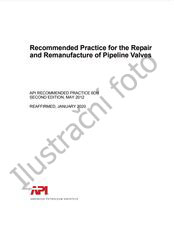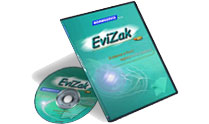Potřebujeme váš souhlas k využití jednotlivých dat, aby se vám mimo jiné mohly ukazovat informace týkající se vašich zájmů. Souhlas udělíte kliknutím na tlačítko „OK“.

API RP 754-ed.3
Process Safety Performance Indicators for the Refining and Petrochemical Industries
Přeložit název
NORMA vydána dne 1.8.2021
Informace o normě:
Označení normy: API RP 754-ed.3
Datum vydání normy: 1.8.2021
Kód zboží: NS-1140253
Počet stran: 134
Přibližná hmotnost: 433 g (0.95 liber)
Země: Americká technická norma
Kategorie: Technické normy API
Anotace textu normy API RP 754-ed.3 :
API RP 754, 3rd Edition, August 2021 - Process Safety Performance Indicators for the Refining and Petrochemical Industries
General
This recommended practice (RP) identifies leading and lagging process safety indicators useful for driving performance improvement. As a framework for measuring activity, status, or performance, this document classifies process safety indicators into four tiers of leading and lagging indicators. Tiers 1 and 2 are suitable for nationwide public reporting and Tiers 3 and 4 are intended for internal use at individual facilities. Guidance on methods for development and use of performance indicators is also provided.
Applicability
NOTE At joint venture sites and tolling operations, the Company should encourage the joint venture or tolling operation to consider applying this RP.
This RP was developed for the refining and petrochemical industries but may also be applicable to other industries with operating systems and processes where loss of containment has the potential to cause harm (see Note). Applicability is not limited to those facilities covered by the OSHA Process Safety Management Standard, 29 CFR 1910.119, or similar national and international regulations.
NOTE To enable consistent application of this RP to other refining and petrochemical industry subsegments, informative annexes have been created to define the Applicability and Process definition for those subsegments. The user would substitute the content of those annexes for the referenced sections of this RP: Annex A—Petroleum Pipeline and Terminal Operation, Annex B—Retail Service Stations, Annex C—Oil and Gas Drilling and Production Operations.
This RP applies to the responsible party. At co-located facilities (e.g. industrial park), this RP applies individually to the responsible parties and not to the facility as a whole.
Events associated with the following activities fall outside the scope of this RP and shall not be included in data collection or reporting efforts:
- a) releases from transportation pipeline operations outside the control of the responsible party;
- b) marine transport operations, except when the vessel is connected or in the process of connecting or disconnecting to the process;
NOTE The boundary between marine transport operations and in the process of connecting to or disconnecting from the process is the first/last step in loading/unloading procedure (e.g. first line ashore, last line removed, etc.).
c) truck or rail transport operations, except when the truck or rail car is connected or in the process of connecting or disconnecting to the process, or when the truck or rail car is being used for on-site storage;
NOTE 1 Active staging is not part of connecting or disconnecting to the process; active staging is not considered on-site storage; active staging is part of transportation.
NOTE 2 The boundary between truck or rail transport operations and in the process of connecting to or disconnecting from the process is the first/last step in loading/unloading procedure (e.g. wheel chocks, set air brakes, disconnect master switch, etc.).
d) vacuum truck operations, except on-site truck loading or discharging operations, or use of the vacuum truck transfer pump;
e) routine emissions from permitted or regulated sources;
NOTE Upset emissions are evaluated as possible Tier 1 or Tier 2 PSEs per 5.2 and 6.2.
f) office, shop, and warehouse building events (e.g. office fires, spills, personnel injury or illness, etc.);
g) personal safety events (e.g. slips, trips, falls) that are not directly associated with on-site response or exposure to a LOPC event;
h) LOPC events from ancillary equipment not connected to the process;
i) quality assurance (QA), quality control (QC), and research and development (R&D) laboratories (pilot plants are included);
j) new construction that is positively isolated (e.g. blinded or air gapped) from a process prior to commissioning and prior to the introduction of any process fluids and that has never been part of a process;
k) retail service stations; and
l) on-site fueling operations of mobile and stationary equipment (e.g. pick-up trucks, diesel generators, and heavy equipment).
Guiding Principles
Performance indicators identified in this RP are based on the following guiding principles.
— Indicators should drive process safety performance improvement and learning.
— Indicators should be relatively easy to implement and easily understood by all stakeholders (e.g. workers and the public).
— Indicators should be statistically valid at one or more of the following levels: industry, company, and facility. Statistical validity requires a consistent definition, a minimum data set size, a normalization factor, and a relatively consistent reporting pool.
— Indicators should be appropriate for industry, company, or facility level benchmarking.
Introduction
Process safety incidents are rarely caused by a single catastrophic failure but rather by multiple events or failures that coincide. This relationship between simultaneous or sequential failures of multiple systems was originally proposed by British psychologist James T. Reason [16] in 1990 and is illustrated by the “Swiss Cheese Model.” In the Swiss Cheese Model, hazards are contained by multiple protective barriers, each of w
Doporučujeme:
EviZak - všechny zákony včetně jejich evidence na jednom místě
Poskytování aktuálních informací o legislativních předpisech vyhlášených ve Sbírce zákonů od roku 1945.
Aktualizace 2x v měsíci !
Chcete vědět více informací? Podívejte se na tuto stránku.



 Cookies
Cookies
